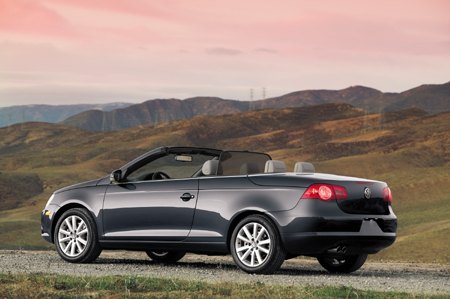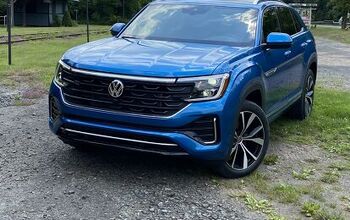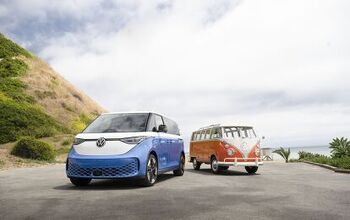Volkswagen Eos Review
There is no way to overstate the appeal of the new Volkswagen Eos’ folding hardtop. I sat inside the car for ten minutes, opening and closing the lid, marveling at the mechanism’s precision and design. What kind of mind can develop something that folds and unfolds with such infinite grace? If you like to visit high speed factories spitting out hundreds of widgets per minute, filling them with liquids and shrink wrapping them in three swift motions, then you will never tire of lowering and raising the Eos’ five-piece hardtop. As for the rest of Vee Dub’s CSC (coupe-sunroof-convertible), it’s danger, boredom ahead.
All the time, effort and money VW’s engineers spent creating and manufacturing the Eos’ hardtop must have been scrimped from the company’s design department. Although there’s plenty of concave and convex “flame surfacing” in the usual places (wheel arches, door bottoms), there’s nothing even mildly warm about the Eos’ overall look. While the detailing takes German minimalism to the next level (dull and insipid), the proportions are the real passion killer. The overhangs are grossly mismatched, the ascending beltline says “tip-toeing bathtub” and the rearwards sloping rear deck is just plain wrong. At best (i.e. after you buy one), the Eos is “cute.” For those of us who remain on the sidelines, "homely and unlovable" is closer to the truth.
As befits a car that was shown as a concept just 18 months ago, the Eos’ interior is a parts bin special. Although the fascia is all new, all the bits slotted in are standard Golf fare— and none the worse for it. It’s a clean look with faultless ergonomics, from cosseting chairs to simple controls. Our tester’s Sport package (about $3500) adds some much needed spizzarkle– aluminum trim and wikkid dials– to the cabin’s otherwise dour demeanor. There aren’t a lot of high tech toys, but the [optional] satellite radio gets channeled through an [optional] mini Marshall stack and the [optional] corner steering xenon lighting makes drivers feel positively Lexian.
Pistonheads note: the folding hardtop VW Eos is no one trick pony. Provided you stump-up for VW’s dual shift gearbox (DSG), it’s a one-and-a-half trick pony. The superb paddle shift system, which has transformed ugly ducklings like the VW GTI and Audi A3 into F1 soaring Eagles, turns the Eos into a runt swan. Credit the extra weight of the hardtop top, its motor and the chassis strengthening needed to maintain torsional rigidity. It does nothing for the car’s dynamics, except spoil them.
VW’s press site pegs the Eos’ curb weight at 3503 lbs. That would make the Eos (which sits on a modified Passat platform) just 195 pounds heavier than a GTI. It feels three times that. Even under full throttle, the DSG labors to make anything happen. The razor-sharp small VW driving experience is decidedly dumbed down. Our tester had the base engine: a 2.0-liter, 200hp, turbocharged four. This mill, so willing and frisky in all the other VW/Audi executions, feels overwhelmed and peaky in this application. If you want to buy this top– I mean car, wait for September, when the factory starts building the Eos with a 250hp V6.
Of course, the Eos’ ponderousness steals more than the accelerative joy normally derived from this engine and transmission combination. The “I can’t believe this is a front driver” handling experience from the GTI is lost as well. Understeer is the party guest from Hell, arriving early and staying late. The props top also seems to unbalance the equation vertically; the Eos navigates curves like an ungainly and top heavy SUV. In addition to the nautical motions, you also get a maritime soundtrack: the top creaks and groans over rough patches like an old wooden schooner.
If the Jetta is all grown up, the Eos is an octogenarian. Its lethargic performance and high quality materials highlight the blue rinse effect. The pricing punctuates these observations. The 2.0-liter Eos starts under $30k, and quickly ascends in the high 30’s. The 3.2 will easily break $40k. Hardtop or no, the GTI is looking more and more like the pick of the litter.
Anyway, the Eos is clearly another “lifestyle” Volkswagen aimed at the empty nest/trustafarian market. While the Eos’ retractable hardtop is nothing new from the likes of the Mercedes (SL/SLK), we’re grateful that the new Vee Dub brings Germany's open and shut case to the masses. If Wolfsburg had attached their wundertop to a more attractive package, they would have had an instant classic. Instead, they’ve built a highly polished though dynamically dull machine whose appeal— and sales— will rely almost entirely on the novelty of its hood. Will that party trick be enough to move the metal? Absolutely.
More by Jay Shoemaker
Latest Car Reviews
Read moreLatest Product Reviews
Read moreRecent Comments
- W Conrad I'm not afraid of them, but they aren't needed for everyone or everywhere. Long haul and highway driving sure, but in the city, nope.
- Jalop1991 In a manner similar to PHEV being the correct answer, I declare RPVs to be the correct answer here.We're doing it with certain aircraft; why not with cars on the ground, using hardware and tools like Telsa's "FSD" or GM's "SuperCruise" as the base?Take the local Uber driver out of the car, and put him in a professional centralized environment from where he drives me around. The system and the individual car can have awareness as well as gates, but he's responsible for the driving.Put the tech into my car, and let me buy it as needed. I need someone else to drive me home; hit the button and voila, I've hired a driver for the moment. I don't want to drive 11 hours to my vacation spot; hire the remote pilot for that. When I get there, I have my car and he's still at his normal location, piloting cars for other people.The system would allow for driver rest period, like what's required for truckers, so I might end up with multiple people driving me to the coast. I don't care. And they don't have to be physically with me, therefore they can be way cheaper.Charge taxi-type per-mile rates. For long drives, offer per-trip rates. Offer subscriptions, including miles/hours. Whatever.(And for grins, dress the remote pilots all as Johnnie.)Start this out with big rigs. Take the trucker away from the long haul driving, and let him be there for emergencies and the short haul parts of the trip.And in a manner similar to PHEVs being discredited, I fully expect to be razzed for this brilliant idea (not unlike how Alan Kay wasn't recognized until many many years later for his Dynabook vision).
- B-BodyBuick84 Not afraid of AV's as I highly doubt they will ever be %100 viable for our roads. Stop-and-go downtown city or rush hour highway traffic? I can see that, but otherwise there's simply too many variables. Bad weather conditions, faded road lines or markings, reflective surfaces with glare, etc. There's also the issue of cultural norms. About a decade ago there was actually an online test called 'The Morality Machine' one could do online where you were in control of an AV and choose what action to take when a crash was inevitable. I think something like 2.5 million people across the world participated? For example, do you hit and most likely kill the elderly couple strolling across the crosswalk or crash the vehicle into a cement barrier and almost certainly cause the death of the vehicle occupants? What if it's a parent and child? In N. America 98% of people choose to hit the elderly couple and save themselves while in Asia, the exact opposite happened where 98% choose to hit the parent and child. Why? Cultural differences. Asia puts a lot of emphasis on respecting their elderly while N. America has a culture of 'save/ protect the children'. Are these AV's going to respect that culture? Is a VW Jetta or Buick Envision AV going to have different programming depending on whether it's sold in Canada or Taiwan? how's that going to effect legislation and legal battles when a crash inevitibly does happen? These are the true barriers to mass AV adoption, and in the 10 years since that test came out, there has been zero answers or progress on this matter. So no, I'm not afraid of AV's simply because with the exception of a few specific situations, most avenues are going to prove to be a dead-end for automakers.
- Mike Bradley Autonomous cars were developed in Silicon Valley. For new products there, the standard business plan is to put a barely-functioning product on the market right away and wait for the early-adopter customers to find the flaws. That's exactly what's happened. Detroit's plan is pretty much the opposite, but Detroit isn't developing this product. That's why dealers, for instance, haven't been trained in the cars.
- Dartman https://apnews.com/article/artificial-intelligence-fighter-jets-air-force-6a1100c96a73ca9b7f41cbd6a2753fdaAutonomous/Ai is here now. The question is implementation and acceptance.





































Comments
Join the conversation
I'd been planning to drive one of these. But when I went to the dealer a few weeks ago, I had to choose between a manual GTI and DSG GLI. I'd already driven a manual GLI, so I went with the DSG car. Has anyone driven both the GLI and GTI? Do they feel any different?
I checked this site in the hopes of useful reviews in search of a new car. What I feel I found is a site organized by a group of testosterone driven teens. The language is trite with pre-packaged phrases, competition for sarcasm the rule. "My dog is better than your dog" disguised as a review. Those who can dig through the "review?" searching for some insight best not question it lest they be driven back by insults. I thought I was on CNet where juveniles argue over who's cell phones or mp3 players "rule". Nothing I found useful.